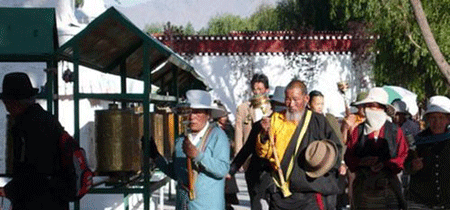
Tibetan Buddhist believers are taking ritual walk during the Sagya Dawa Festival, photo from China Tibet Information Center.
Norsang crawled on the ground and prostrated herself as she moved through the crowds on the Potala Palace square in Lhasa.
With two spiral sea shells, or conches, in hand, Norsang had made hundreds of bows on Friday morning as the month-long Sagya Dawa Festival started.
A Tibetan woman in her 30s, she said she prayed for her family to lead safe and happy lives.
The festival, which falls on the first day of the fourth month of the Tibetan lunar calendar, commemorates the birth and death of Sakyamuni, founder of Buddhism.
According to the regional tourism authority, Tibet expects to receive 6.5 million tourists this year, up 16 percent from last year.
Over the next month, Tibetans will hold Buddhist rituals such as the release of captive animals in memory of Sakyamuni.
On Friday, pilgrims were seen at major monasteries and streets in Lhasa, some from neighboring provinces. Tourists from abroad also took in the sights.
Sambo, in red monk’s robes, drove 11 hours to Lhasa from Chakri Monastery in Nagqu county.
He and his friends planned to stay for the whole month.
“I pray for a peaceful and safe world, and hope quake victims in Yushu will find way their to heaven,” he says.
While some devout Tibetan Buddhists made long prostrations, others held prayer wheels and walked clockwise around the Potala Palace and the Jokhang Monastery, two major pilgrim routes in downtown Lhasa.
Chodron, 32, carrying her 3-year-old boy on her back and holding her 10-year-old girl by hand, walked around the Potala Palace. They were accompanied by two relatives from other regions in Tibet.
Twirling a prayer wheel, Chodron says they have walked around the Potala Palace twice since early Friday, and planned another three circuits.
In the square outside the Jokhang Monastery, hundreds of pilgrims crawled on the ground facing the temple and prostrated themselves on meter-long cushions.
Near the temple, Drolma was selling yak butter to pilgrims. The liquid yellow butter is used to fuel lamps in the temple.
Drolma said she had sold 10 pots of butter in two sizes, at 13 yuan ($1.9) or 25 yuan per pot, in the morning. “Business is good as people stream in during the festival,” she said.
Long queues formed outside the main shrine of the Jokhang Monastery. Inside, banknotes donated by pilgrims lay spread out in front of each Buddha statue and portrait.
Source : http://chinatibet.people.com.cn




